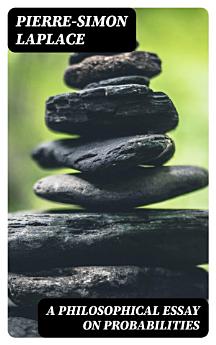A Philosophical Essay on Probabilities
Pierre-Simon Laplace
Sep 2022 · DigiCat
Ebook
137
Pages
family_home
Eligible
info
reportRatings and reviews aren’t verified Learn More
About this ebook
In "A Philosophical Essay on Probabilities," Pierre-Simon Laplace presents a foundational work that delves into the principles of probability theory and its philosophical implications. Written in 1814, this essay is characterized by Laplace's methodical literary style, integrating mathematical rigor with contemplative inquiry. Contextually, it emerged during the Enlightenment, a period marked by a growing fascination with rational thought and empirical evidence, positioning Laplace's work as a pivotal convergence of science and philosophy, where he explores the nature of uncertainty and the predictability of events through mathematical paradigms. Pierre-Simon Laplace was a prominent French mathematician and astronomer whose groundbreaking contributions helped shape modern statistics and probability theory. His background in the sciences, particularly his work in celestial mechanics, informed his profound interest in understanding chance and causality. Laplace's quest to apply deterministic insights to probabilistic situations reflects his broader philosophical engagements, particularly exemplified in his famous assertion that, given complete knowledge of a system, one could predict its future state with certainty. This seminal work is highly recommended for anyone curious about the interplay between science and philosophy. It serves as both an intellectual introduction and a comprehensive analysis of probability's implications, making it a critical read for scholars, mathematicians, and anyone interested in the foundations of rational thought and decision-making in uncertain contexts.
About the author
Pierre-Simon, marquis de Laplace (1749–1827), was a distinguished French scholar whose work was pivotal to the development of mathematical astronomy and statistics. Born in Beaumont-en-Auge, Normandy, Laplace proved to be an exceptional student, particularly in mathematics. He was admitted to the University of Caen, and later moved to Paris, where his acumen in mathematics earned him a position teaching military engineers at the École Militaire. His extensive contributions to celestial mechanics are encapsulated in his five-volume series, 'Mécanique Céleste' (1799–1825), which sealed his reputation as a leading scientist. In this seminal work, Laplace elaborated on and extended the work of his predecessors, such as Newton, to explain the complex motions of planets and the stability of the solar system. Beyond his astronomical research, he made significant strides in the field of probabilities. His 'Essai philosophique sur les probabilités' ('A Philosophical Essay on Probabilities') is an important work that lays out a systematic approach to probability and its application to the physical sciences, illustrating Laplace's deep understanding of the subject. Within this essay, he introduced what is now known as Laplace's Rule of Succession and other foundational concepts. His literary style in mathematical exposition is marked by rigor and clarity, ensuring that his work remains influential. Collectively, Laplace's scientific endeavors place him among the pantheon of great Enlightenment thinkers who profoundly shaped modern science.
Rate this ebook
Tell us what you think.
Reading information
Smartphones and tablets
Install the Google Play Books app for Android and iPad/iPhone. It syncs automatically with your account and allows you to read online or offline wherever you are.
Laptops and computers
You can listen to audiobooks purchased on Google Play using your computer's web browser.
eReaders and other devices
To read on e-ink devices like Kobo eReaders, you'll need to download a file and transfer it to your device. Follow the detailed Help Center instructions to transfer the files to supported eReaders.






